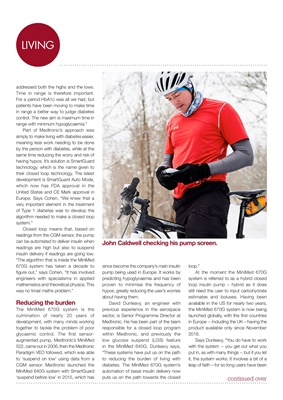
LIVINGLIVING
continued over
we knew we needed a solution that
addressed both the highs and the lows.
Time in range is therefore important.
For a period HbA1c was all we had, but
patients have been moving to make time
in range a better way to judge diabetes
control. The new aim is maximum time in
range with minimum hypoglycaemia."
Part of Medtronic's approach was
simply to make living with diabetes easier,
meaning less work needing to be done
by the person with diabetes, while at the
same time reducing the worry and risk of
having hypos. It's solution is SmartGuard
technology, which is the name given to
their closed loop technology. The latest
development is SmartGuard Auto Mode,
which now has FDA approval in the
United States and CE Mark approval in
Europe. Says Cohen, "We knew that a
very important element in the treatment
of Type 1 diabetes was to develop the
algorithm needed to make a closed loop
system."
Closed loop means that, based on
readings from the CGM sensor, the pump
can be automated to deliver insulin when
readings are high but also to suspend
insulin delivery if readings are going low.
"The algorithm that is inside the MiniMed
670G system has taken a decade to
figure out," says Cohen, "It has involved
engineers with specialisms in applied
mathematics and theoretical physics. This
was no trivial maths problem."
Reducing the burden
The MiniMed 670G system is the
culmination of nearly 20 years of
development, with many minds working
together to tackle the problem of poor
glycaemic control. The first sensoraugmented pump, Medtronic's
MiniMed
522, came out in 2006, then the Medtronic
Paradigm VEO followed, which was able
to 'suspend on low' using data from a
CGM sensor. Medtronic launched the
MiniMed 640G system with SmartGuard
'suspend before low' in 2015, which has
since become the company's main insulin
pump being used in Europe. It works by
predicting hypoglycaemia and has been
proven to minimise the frequency of
hypos, greatly reducing the user's worries
about having them.
David Dunleavy, an engineer with
previous experience in the aerospace
sector, is Senior Programme Director at
Medtronic. He has been part of the team
responsible for a closed loop program
within Medtronic, and previously the
low glucose suspend (LGS) feature
in the MiniMed 640G. Dunleavy says,
"These systems have put us on the path
to reducing the burden of living with
diabetes. The MiniMed 670G system's
automation of basal insulin delivery now
puts us on the path towards the closed
loop."
At the moment the MiniMed 670G
system is referred to as a hybrid closed
loop insulin pump - hybrid as it does
still need the user to input carbohydrate
estimates and boluses. Having been
available in the US for nearly two years,
the MiniMed 670G system is now being
launched globally, with the first countries
in Europe -- including the UK - having the
product available only since November
2018.
Says Dunleavy, "You do have to work
with the system -- you get out what you
put in, as with many things -- but if you let
it, the system works. It involves a bit of a
John Caldwell checking his pump screen.